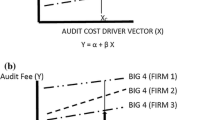Abstract
An institutional auditing program typically consists of the following steps: a sample audit, the decision to move to the full audit, a settlement offer, and the full audit. Statistical sampling techniques are often used to estimate the overbilling percentage and amount. This paper discusses the optimal settlement offer, the net recovery through auditing, the condition for the auditors to move to the full audit, and how an auditing program can be truly cost-effective. This paper provides an evaluation for the statistical sampling techniques to an auditing program. The economic incentives of a contractor to overbill are also identified. Finally, it presents the key metrics and the managerial implications for auditing managers to design or enhance their auditing programs.

Similar content being viewed by others
Notes
References
Andreoni, J., Erard, B., & Feinstein, J. (1998). Tax compliance. Journal of Economic Literature, 36, 818–860.
Bebchuk, L. (1984). Litigation and settlement under imperfect information. RAND Journal of Economics, 15, 404–415.
Bebchuk, L. (1996). A new theory concerning the credibility and success of threats to sue. Journal of Legal Studies, 25, 1–25.
Cooter, R. D., & Rubinfield, D. L. (1998). Economic analysis of legal disputes and their resolution. Journal of Economic Literature, 27, 1067–1097.
Darby, M. R., & Karni, E. (1973). Free competition and the optimal amount of fraud. Journal of Law and Economics, 16(1), 67–88.
Daughety, A. F. (2000). Settlement. In B. Bouckaert & G. De Geest (Eds.), Encyclopedia of law and economics. London: Edward Elgar.
Dulleck, U., & Kerschbamer, R. (2006). On doctors, mechanics, and computer specialists: The economics of credence goods. Journal of Economic Literature, 44, 5–42.
Emons, W. (1997). Credence goods and fraudulent experts. RAND Journal of Economics, 28(1), 107–119.
Franzoni, L. A. (1999). Negotiated enforcement and credible deterrence. Economic Journal, 109(458), 509–535.
Franzoni, L. A. (2004). Discretion in tax enforcement. Economica, 71, 369–389.
Franzoni, L. A. (2008). Tax compliance. In B. Bouckaert & G. De Geest (Eds.), Encyclopedia of law and economics. London: Edward Elgar.
Hay, B., & Spier, K. (1998). Litigation and settlement. In P. Newman (Ed.), The new Palgrave dictionary of economics and the law. London: MacMillan.
Kennan, J., & Wilson, R. (1991). Bargaining with private information. Journal of Economics Literature, 31, 381–399.
Kritzer, H. (1991). The justice broker: Lawyers and ordinary litigation. New York: Oxford University Press.
Lerman, L. G. (1990). Lying to clients. University of Pennsylvania Law Review, 138, 659–760.
Lohr, S. (1999). Sampling design and analysis. Pacific Grove, CA: Duxbury Press.
Macho-Stadler, I., & Péres-Castrillo, J. D. (2004). Settlement in tax evasion prosecution. Economica, 71, 349–368.
McCluskey, J. J. (2000). A game theoretic approach to organic foods: An analysis of asymmetric information and policy. Agricultural and Resource Economics Review, 29, 1–9.
Pitchik, C., & Schotter A. (1987). Honesty in a model of strategic information transmission. American Economic Review, 77, 1032–1036.
Polinsky, A. M., & Shavell, S. (2007). The theory of public enforcement of law. In A. M. Polinsky & S. Shavell (Eds.), Handbook of law and economics. Amsterdam: Elsevier, North-Holland.
Reinganum, J. F., & Daughety, A. F. (1994). Settlement negotiations with two-sided asymmetric information: Model duality, information distribution and efficiency. International Review of Law and Economics, 14, 283–298.
Richmond, D. R. (2008). For a few dollars more: The perplexing problems of unethical billing practices by lawyers. S.C.L. Review, 63–70.
Schweizer, U. (1989). Litigation and settlement under two sided incomplete information. Review of Economic Studies, 56, 163–177.
Spier, K. E. (1992). The dynamics of pretrial negotiation. Review of Economic Studies, 59, 93–108.
Wolinsky, A. (1993). Competition in a market for informed experts’ services. RAND Journal of Economics, 24, 380–398.
Author information
Authors and Affiliations
Corresponding author
Appendix
Appendix
Proof of Eq. (9):
When π(ρ, 1) > π(1, 1)
\(\square\)
Rights and permissions
About this article
Cite this article
Kuo, C. An Economic Analysis on Overbilling Incentives and Auditing Programs. J Bus Ethics 121, 441–449 (2014). https://doi.org/10.1007/s10551-013-1727-x
Received:
Accepted:
Published:
Issue Date:
DOI: https://doi.org/10.1007/s10551-013-1727-x



